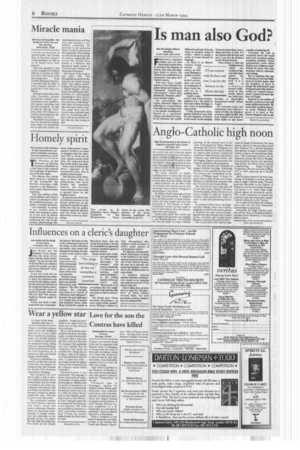Page 6, 25th March 1994
Page 6

Report an error
Noticed an error on this page?If you've noticed an error in this article please click here to report it.
Tags
Share
Related articles
Between Two Worlds And Two Churches
Anglo-catholics To Continue Their Fight
Roman Option Hopes Renewed
London Anglican Parish Crosses Tiber
Anglicans May Flee To Rome
Anglo-Catholic high noon
High Churchmanship In the Church of England by Kenneth Hylson-Smith, T&T Clark, £30 AT LUNCH THE DAY AFTER the Synod announced the ordination of women, a group of High ChuAlh priests-to-be sat disconsolately arourficl the table in their theological college ecoming increas, jingly depressed, on f liern pointed to a spoon in &ant of and cried "You might as well ordain that!"
The many enemies of AngloCatholics point to stories like this and chuckle knowingly. It simply confirms to them what they have always thought Anglo-Catholics are an effete body of eccentrics who spend as much time moaning to their scented colleagues as ministering to their flock.
Dr Hylson-Smith's thorough account of High Churchmanship in England from the Reformation to today demonstrates just how stupid and cruel this caricature is. The history of AngloCatholicism written on these pages is one of extraordinary force and passion, dedication and holiness.
People often think that smells and bells began with Newman, but arguably it was Richard Hooker (1554-1600) who was the father of Anglo-Catholic
theology. In his seminal book of the Laws of Ecclesiastical Polity, Hooker presented the Church of England as a via media between two schools which, he argued, had betrayed traditional catholicity. Both Puritans and Roman Catholics were inherently sinful; only the English Church could preserve the Catholic faith from all corruptions.
This view formed the bedrock of Anglo-Catholic theology. Following Hooker, it was amplified by the Caroline divines and exemplified in the career of William Laud. It found its poetic form in John Donne and George Herbert; its clerical form emerged with the Non-Jurors and Joseph Butler.
But of course the story really takes off in mid-19th century Oxford. The three Tractarian giants, Keble, Newman and Pusey, sought to rally the Anglican Church round conservative values in order to stave off encroaching liberalism.
In contrast to their dreary old Highand-Dry bishops, these true Catholic Anglicans revered the Eucharist, gloried in Tradition as a main source of teaching and were shot through with a "sense of awe, reverence and wonder before the grace, mercy and holiness of God".
The century after 1845 was the high
noon for Anglo-Catholicism.The slum priests, adored by the poor they served and despised by a church hierarchy they ignored, brought a colourful Christianity to places of unremitting bleakness. The missionary priests, led by legendary monks like Trevor Huddleston,excoriated racism and apartheid long before the liberal press .started
complaining. Anglo-Catholic Congresses, like the one held at White City in 1933, attracted up to 50,000 people.
But for many reasons it all went sour. Vatican II heralded a serious identity crisis in Anglo-Catholic ranks. The new post-war liberalism in the Church of England, and the succcessful Evangelical riposte to it, made High Anglicanism appear an anomalous option. The recent ordination of women has polarised, and thus attenuated, AngloCatholic influence in the Church.
So as some priests flunk off to Rome, those who stay will find themselves increasingly marginalised.
Eventually the High Church tradition will die. But, as Dr Hylson-Smith's excellent book illustrates, it was great while it lasted.
PIERS MCGRANDLE
blog comments powered by Disqus













